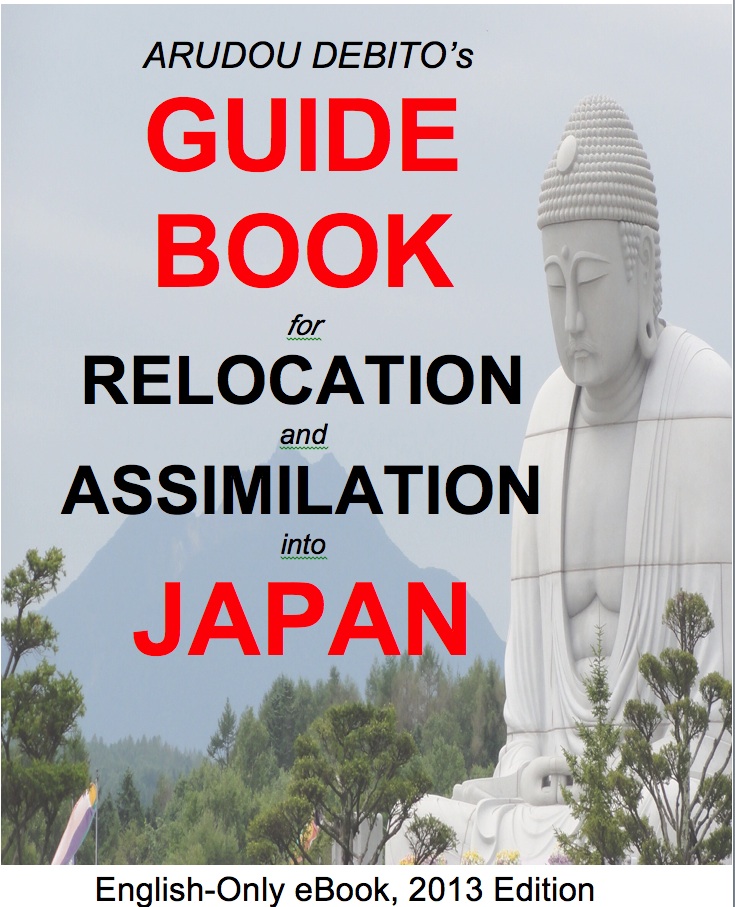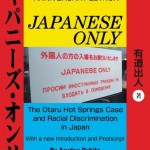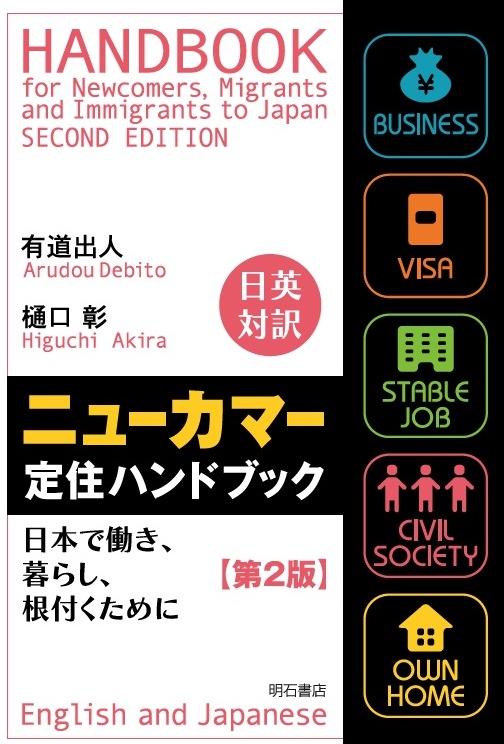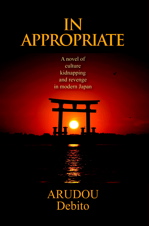mytest
eBooks, Books, and more from Dr. ARUDOU, Debito (click on icon):





![]()


UPDATES ON TWITTER: arudoudebito
DEBITO.ORG PODCASTS on iTunes, subscribe free
“LIKE” US on Facebook at http://www.facebook.com/debitoorg
http://www.facebook.com/handbookimmigrants
https://www.facebook.com/JapaneseOnlyTheBook
https://www.facebook.com/BookInAppropriate
If you like what you read and discuss on Debito.org, please consider helping us stop hackers and defray maintenance costs with a little donation via my webhoster:

All donations go towards website costs only. Thanks for your support!
Hi Blog. A great little tangent from The Economist’s Christmas Special of 2012. This story is fantastic (in fact, it beggars belief), and it answers a number of questions I always had about the status quo in Japan (especially when it comes to the interlocking of politics and media). I thought Watanabe Tsuneo (of the same publishing empire; the Yomiuri) is one of Japan’s most morally-corrupt powerful men. This guy beats him. Dr. ARUDOU, Debito
/////////////////////////////////////////////////////
Matsutaro Shoriki
Japan’s Citizen Kane
A media mogul whose extraordinary life still shapes his country, for good and ill
The Economist. Dec 22nd 2012 | From the print edition
http://www.economist.com/node/21568589/print
THE ECONOMIST’S office in Tokyo is in the headquarters of the Yomiuri Shimbun, the world’s biggest-selling newspaper. Every day, as you walk past bowing guards and immaculate receptionists, set back in a corner you pass a bronze statue of an owlish man with a bald head and thick, round-rimmed glasses, poring over a paper. He is Matsutaro Shoriki (pictured), who acquired the paper in its left-wing adolescence in the 1920s, and turned it into a scrappy, sensational pugilist for right-wing politics. The statue is not flattering: with his potato-like head and beakish nose, he seems to be pecking at the newspaper rather than reading it.
Shoriki lurks in the background of much of 20th-century Japan, too. He created so much of what defines the nation today that it is a wonder he is not as well known as, say, William Randolph Hearst (one of his big Western admirers) is in America. Shoriki was as much the pugnacious, brooding, manipulative and visionary “Citizen Kane” as Hearst.
Before he took over the Yomiuri, Shoriki was head of Tokyo’s torturous secret police. Later, to help him sell papers, he introduced professional baseball to Japan. After the second world war he was jailed for alleged war crimes; upon his release he set up Japan’s first private television network. To cap it all, he was the “father of nuclear power”, using his cabinet position and media clout to transform an atom-bombed nation into one of the strongest advocates of atomic energy. That legacy now smoulders amid the ruins of the Fukushima Dai-ichi nuclear plant.
Victories of the spirit
Japanese history is peppered with stories of giants whom almost no one outside the country has ever heard of. Because of Japan’s reverence for humility, their tales tend to be subsumed within the companies or projects the individuals created. Shoriki is different. There is nothing humble about him: his is a story of ruthless ambition, bordering on megalomania.
He got a taste for power early, when he rose like a rocket through the police force. He was 28 when, in 1913, he joined the Metropolitan Police. He had recently graduated from the elite University of Tokyo, but was more interested in judo than studying, so had failed the civil-service entrance exams. Police work carried lower prestige, but it suited him. Within a year he was promoted to head a police station in Nihonbashi, the old heart of the city.
Japan’s economy was booming. The first world war was a godsend for a country that was undergoing breakneck modernisation. After its own military victories against Russia and China, and the annexation of Korea in 1910, Japan was puffed up with pride at being one of the world’s colonial powers. But the Bolshevik Revolution of 1917 brought a ferment of new ideas—including the demand for wider male suffrage in Japan—which the police and the patrician old guard viewed with alarm. Shoriki was put in charge of suppressing student demonstrations at Waseda University, then one of Tokyo’s most liberal institutions. He later introduced a masseur, masquerading as a communist, to entrap three radical professors. To this day, Waseda’s left-wingers loathe him.
In 1918 he astutely predicted the spread of rice riots from Toyama, the rural prefecture where he was born, to Tokyo. When he marched among the rioters, his sword tethered to his side to show he did not mean violence, a jagged stone hit him on the head. His courage in persuading the mob to calm down, with blood streaming down his face, appears to show him at his best. In “Shoriki: Miracle Man of Japan”, a biography published in 1957 (and regarded by some as a ghostwritten auto-hagiography), Edward Uhlan and Dana Thomas, two American journalists, describe the moment in which he “dispersed a frenzied mob without raising a finger” as the greatest “victory of the spirit” in his life.
But he was no saint. As communist agitation spread in the early 1920s, and Koreans in Japan increasingly rebelled against colonisation, Shoriki was promoted to be chief of staff of the Metropolitan Police, which in effect made him head of the secret police. He had responsibility for infiltrating labour and Korean groups and rooting out the “red menace”.
Then in September 1923, shortly after the Japanese Communist Party had been formed, Tokyo and nearby Yokohama suffered a devastating earthquake that, coupled with the ensuing fires, killed more than 100,000 people. An orgy of opportunistic anti-Korean slaughter followed, which Shoriki may have stoked and then diverted into an attack on socialists.
When, a few months later, professional catastrophe struck, his extensive political connections rescued him. On his watch, a young socialist tried to kill the Crown Prince (later Emperor Hirohito), an event for which Shoriki was given the harshest sanction: “disciplinary dismissal”. Thrown out of work, it occurred to him that newspapers might be an influential business. The Yomiuri Shimbun was struggling, having just built a new headquarters that collapsed in the earthquake. Shoriki needed ¥100,000 ($20,000 then) to buy it out; he turned to one of his contacts, a leading right-wing politician, for financial support. It was a shrewd investment: Shoriki turned the Yomiuri into an establishment crusader.
Evidence of the personality that he quickly stamped upon it can be found in the Yomiuri’s sixth-floor library. You need to borrow the librarian’s magnifying glass to read the tight old kanji, or Chinese script, in which the paper was written. But it is quickly apparent that under him it was a much livelier read than the staid stuff it serves up nowadays. This was Japan’s “Taisho era”, a rare time of democratic upheaval and self-indulgence, summed up in the phrase eroguronansensu, or erotic, grotesque nonsense. That quickly became Shoriki’s sales pitch for the Yomiuri, though because he spoke not a word of English he mangled the terms into “grotic” and “erotesque”.
Never mind: it worked. Next to lurid stories about adultery and photos of flapper-era mogas (modern girls) are advertisements for clinics treating the consequences (“Before the parties at the end of the year, you should sort out your gonorrhoea”). There are pages about hit songs from the new craze of radio that was sweeping the country, a trend that Japanese newspapers had until then ignored. In 1931, when Japan invaded Manchuria, Shoriki seized the moment to go head-to-head with his bigger Tokyo rivals, the Asahi and the Mainichi, by launching an evening edition to bring readers sizzling China-bashing updates from the front.
Two years later, in 1933, comes an episode of vintage Shoriki. His editors had noticed the rising incidence of suicide; one popular method was for couples to hurl themselves hand-in-hand into a fiery volcano called Miharayama, on a Pacific island a long boat ride from Tokyo. In one year 944 people had taken the plunge: at a time of growing militarism, this was not regarded as a very patriotic endeavour.
Into the volcano
The Yomiuri decided it should warn people what they were throwing themselves into. With a flurry of publicity, the paper told its readers it would separately lower an editor and a photographer towards the molten furnace in a gondola. But first the paper sent down two animals to test for poisonous gases, eliciting the priceless headline: “Monkey paralysed. Rat dead.” When the gas-masked journalists did make it, they descended 415 metres, which the Yomiuri claimed was a world record. One of them relayed sightings of corpses to the surface by jerry-rigged telephone. It made for wonderful copy, but did nothing to stop the suicides.
This cloak of supposed public interest, wrapped around gory sensationalism, sent the Yomiuri’s circulation soaring. Between 1924 and 1937 it rose from 58,000 to 800,000, a feat that made the Yomiuri the biggest newspaper in Tokyo.
Banzai Babe
The melding of commercial pragmatism with ideological dogma shaped much of Shoriki’s career. But another factor also defined the second half of his life: his relationship with America.
Baseball was its first manifestation. Shoriki was no baseball fan, but he knew he could use the sport to sell newspapers. The trouble was that Japan had no professional baseball teams. So, on the advice of a rival newspaper proprietor, he set out to bring Babe Ruth, the legendary Yankees slugger, to Tokyo. At first, Ruth was too busy: he did not join the all-star team that came out to Japan to play for capacity crowds in 1931. But in 1934, past his prime and noticeably overweight, he finally arrived.
It was a tense time, both within Japan and in its diplomacy. Soldiers burning with fascist zeal were assassinating government moderates in a bid to rekindle the traditional “spirit” of Nippon. The visit was controversial, coming just as Japan appeared to be turning its back on the outside world. But Shoriki’s intuition worked: ordinary Japanese went mad for Ruth and his team. Tens of thousands packed the streets of Ginza to see them parade in open-top cars. People thronged the Meiji stadium to watch them play, most barely minding (though Shoriki did) that the home sides usually lost.
Ordinary Japanese went mad for Ruth and his team. Tens of thousands packed the streets of Ginza to see them parade in open-top cars. People thronged the Meiji stadium to watch them play, most barely minding (though Shoriki did) that the home sides usually lost.
Not everyone was so thrilled: a madcap group called the “War God Society” protested at the Americans’ “defilement” of grounds sacred to the Meiji emperor. Not long afterwards Shoriki was stabbed in the neck with a Japanese sword by an ex-policeman who professed to hate his pro-Americanism. He lost a litre of blood and nearly died. Undeterred, Shoriki founded the Yomiuri Giants baseball team, which has dominated the sport in Japan ever since.
This relationship with America would be twisted by war. The Yomiuri, like all its rivals, was a fervent cheerleader for Japan’s Pacific conquests; as the imperial army advanced south, so the Yomiuri set up offices and newspapers around South-East Asia. When the war ended in 1945 the charge-sheet against Shoriki looked strong: he had been a director of the quasi-fascist Imperial Rule Assistance Association, set up in 1940, which promoted war. His newspaper was suspected of being a propaganda organ of the militarists. Damningly, many of the strongest accusations of fascism that were made against him came from his own writers and editors.
The Yomiuri was in revolt at the time. At the end of the war, encouraged by the liberal ideas of the American occupation, a group of left-wing journalists staged a coup at the paper. For months the internal battle spilled onto the front pages. Headlines branded Shoriki a war criminal, even as he continued to show up as publisher each day. By December he was locked up in Sugamo Prison with the rest of Japan’s suspected warmongers, charged with Class A war crimes.
The nuclear option
Prison was a bitter ordeal. Shoriki took to meditating for many hours a day, while pulling every string he could to clear himself. In the digital dossiers of the Tokyo War Crimes Trials, which are published online by the University of Virginia, he even at one stage begs for his release on the ground that “the life of the Yomiuri Shimbun is at stake”.
Suddenly, it seems, his American jailers decided that most of the accusations against Shoriki were of an “ideological and political nature”, made by striking employees who deserved little credence (America was growing nervous of the left-wing unionism it had inadvertently nurtured). On August 22nd 1947 a recommendation was made to free Shoriki, and he walked out after 21 months inside. Though still purged from public life, he would later claim that his spell at “Sugamo University” was an ideal networking opportunity. It gave him access to right-wingers who would come back to rule the country, with Shoriki’s help, just four years after America finally signed a peace treaty with Japan in 1951.
But by this stage Shoriki was 62, and had an enormous cliff to climb to achieve what he most passionately craved: political power. He used two means to get there: television, then nuclear energy. Both enterprises involved a man whose influence hangs over Shoriki’s later years, Hidetoshi Shibata. He was the main source for another biography of Shoriki, by Shinichi Sano—the premise of which is that Shoriki stole most of his ideas from his underlings, and jealously took all the credit for himself. But in Shibata’s case, at least, the two seem to have used each other.
Shibata, a news reporter, heard of a plan put forward in America to use television to spread anti-communist propaganda around the world, with the former enemies West Germany and Japan as the bases. He brought the idea to Shoriki, who offered to help finance a new station—if the Americans helped persuade the Supreme Commander for the Allied Powers to lift his blacklisting. Using Shibata’s American contacts, Shoriki browbeat the government to end the monopoly of NHK, the state broadcaster. His purge duly lifted, he raised more than ¥800m to establish Japan’s first private network, Nippon Television, in 1952. Today it is the most popular TV station in Japan.
But television was only the next stage in his journey. By 1954 Japan was in the grip of anti-American hysteria. After the horrors of the atomic bombings of Hiroshima and Nagasaki, American H-bomb testing in the Pacific Marshall Islands blanketed 23 Japanese tuna fishermen with radioactive ash. After one of the men affected died, anti-nuclear passions soared. Shoriki, as well as America’s CIA, was terrified at the thought that the Soviet Union and China might take advantage of the uproar to displace American influence in Japan.
He hit upon another remarkable plan, this time to use nuclear energy as a tool of pro-American leverage. Yet another biographer claims this was a CIA plot—an idea pooh-poohed by other scholars, who believe that Shoriki exploited the Americans at least as much as vice versa. Dwight Eisenhower had recently made his “Atoms for Peace” speech, promoting the spread of nuclear energy to counter the stigma of nuclear weapons. In December 1954 John Jay Hopkins, president of General Dynamics, a pioneering nuclear conglomerate, suggested an “Atomic Marshall Plan” for Japan.
Shoriki pressured Hopkins to travel to Tokyo to deliver the message in person; at the first hint of assent, the Yomiuri splashed the news on its front page. With all the hoopla that had heralded the arrival of Babe Ruth more than 20 years earlier, the paper played up the visit in May 1955. Shoriki used giant screens artfully erected on street corners both to spread the pro-nuclear message and to boost the fledgling NTV’s ratings.
At the same time he and some of his pronuclear cronies in parliament were pulling strings, with results that still resonate. He won a Diet seat on a nuclear-energy platform, then helped form the Liberal Democratic Party. It ruled Japan for almost all of the next 55 years (and is now returning to power). In January 1956, as a cabinet member of the first LDP government, he was appointed president of Japan’s new Atomic Energy Commission. To the surprise and horror of some of the scientists on the commission, his first announcement was that Japan would have a reactor within five years. He never let practicalities get in the way of a story.
This was not quite the end. Ultimately, Japan got its reactors (ironically, the first was British, not American). But Shoriki could not secure his biggest goal, the premiership, and perhaps it was this shortcoming that ultimately racked him with a sense of failure. The end of his life story is told by Yasuko Shibata, the 82-year-old wife of his former right-hand man, who lives in a sumptuous retirement home in Yokohama. She giggles as she recalls how Shoriki once offered her a thick envelope of cash, after her husband had stormed off following one of the two men’s many rows. To her, at least, he was neither a monster nor a patsy. “It doesn’t matter whether you like Shoriki or not, he was not the kind of small guy that the CIA could push around,” she insists.
Mrs Shibata tells a story of Shoriki’s final days in 1969 that reveals, like Orson Welles’s “Citizen Kane”, how tortured he was at the end. His own wife had died, and he had moved into a dingy room in Tokyo with his mistress. Lying in her arms and approaching death himself, he heard revellers drinking outside and, in a feverish state, thought it was Shibata threatening to kill him unless he was given the credit he deserved. Shoriki need not have worried about his own legacy. For good or ill, it lingers on.
From the print edition: Christmas Specials
ENDS
6 comments on “Tangent: Economist on “Japan’s Citizen Kane”: Shouriki Matsutaro; explains a lot about J-media’s interlocking relationship with J-politics”
Typical seed of Abe Zeitgeist. Right wing fascist? Check. But Pro American aspects (so he got off)-check. but actually manipulating America? Check. Pro nuclear power? check.Anti Korean? check.
I think he must be an ancestor of Ishihara…
Well, this guy certainly set the standard that he was able, by way of his newspaper, to beget as the post-war checklist for wannabe J-right-wingers.
To sum it up, this czar is a founder of Japanese version of Abner Doubleday(baseball) & Rupert Murdoch (newspapers) rolled into one?
@Loverilakkuma
It was Alexander Cartwright who invented the sport of modern baseball, not Doubleday. A better example to compare Shoriki to would be Cap Anson, who not only promoted the sport of baseball but also founded the National League.
Although I should say that it might be better to compare Shoriki to the Frank Doubleday who founded the Doubleday publishing company. Years later, that same company would buy the New York Mets. (Currently, they’re owned by Frank Wilpon.)
@Edward: One more correction is needed. Al Spalding is the person you’re thinking of, at least more so than Cap Anson. Anson was still a young first baseman when the Chicago team that Spalding pitched for took the inaugural National League championship in 1876. Spalding also organized a world tour in the 1888-89 winter that brought baseball to various countries — there is a wonderful picture of the players standing in front of the Sphinx in Egypt — which was paralleled by the 1930s tours of Japan which Shoriki organized.
Spalding, of course, went into the sporting goods business to make his real fortune. And though I think he took a shot at politics in his later years, as far as I know, there are no ties between him and any war criminals, ultranationalists, or other shadowy figures.
@Ed & Mark
Thank you. That’s very analytical.